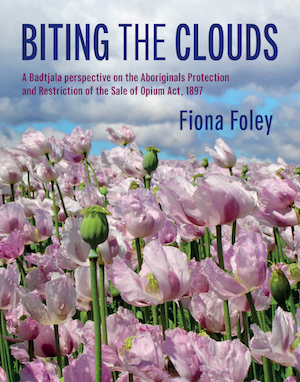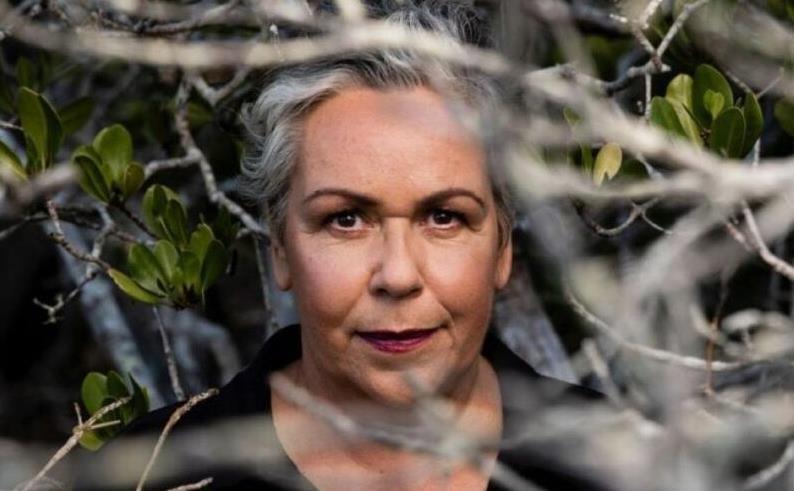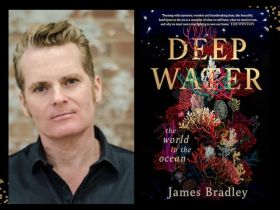Fiona Foley’s Biting the Clouds is an exceptional commentary on the history of the colonisation of K’gari (Fraser Island, an island off the coast of Queensland) and Queensland more broadly. It is exceptional for two reasons. The first is that Foley, a Badtjala woman, writes about the colonisation of her country, K’gari, from a Badtjala perspective, helping fill a critical gap in colonial historiography in Australia. The second is that, as a visual artist, Foley uses photos and descriptions of art and art installations to express ideas, sentiments and concepts – from an Aboriginal perspective specifically – that may be absent in historical accounts.
An example of such a work is an installation where the letters of the word ‘dispersed’ have been individually sculpted and placed against a white wall; the letter D has large bullets jutting out of it. In this work, Foley negotiates the ‘doublespeak’ of old colonial policies and judicial, political and historical documents, wherein accounts of the ‘settlement’ of the land and ‘dispersal’ of Aboriginal nations – underpinned by the deceptively benign concepts of ‘settlement’ and ‘dispersal’ respectively – belied the harsh realities of Aboriginal loss of life and violent displacement from country.
This is especially important because, as Foley writes, the frontier wars in Queensland, and in the Wide Bay-Burnett region more specifically, were, in fact, extremely violent. Foley writes passionately about the Badtjala resistance to colonisation, highlighting historical accounts of government and settler anxiety about the persistent Aboriginal challenges to incursions into this region, particularly in the town of Marysborough and in Fraser Island.
Citing the work of historians such as Raymond Evans, Rosalind Kidd, Henry Reynolds, Jonathan Richards and others, Foley methodically delineates the different elements of the frontier wars in Queensland, including the settler takeover of country and belligerence towards traditional owners, violence by settler vigilante groups and state-sponsored armed groups such as the Native Police, and traditional owners’ resistance to these. The Native Police, which recruited from among vanquished and displaced Aboriginal nations in Victoria and New South Wales, was particularly violent. It was responsible for mass killings in Fraser Island and the Bunya Mountains, where Aboriginal nations from Queensland and New South Wales gathered for ceremony and trade.
Silence is a key concept in Foley’s book. She writes about settler vigilantes’ and the Native Police’s silences about the toll of their murderous exploits. ‘A deliberate code of secrecy employed by state and squattocracy’ resulted in obfuscation of the magnitude of the decimation of Aboriginal peoples. Nevertheless, as Foley writes, surviving accounts of the frontier wars from settlers’ letters and government inquiries attest to widespread violence and brutality.
Read: Book Review: No Friend but the Mountains by Behrouz Boochani (Pan Macmillan Aus)
Silence is also a key concept in Foley’s art. She writes about her artwork in the second part of the book, focusing on, among other works, Black Opium, which engages with the regulation of opium consumption among Aboriginal people, particularly those co-opted into the Aboriginal reserve system conceived by colonial authorities in Queensland in the late nineteenth century. Foley unpacks the implicit beliefs and attitudes that governed this system and the linked The Aboriginals Protection and Restriction of the Sale of Opium Act (1897). An implicit acceptance of the presumed inevitability of Aboriginal decline was a key part of colonial regulation of Aboriginal lives during this time.
Foley also describes how she negotiated the particular challenges, in dealings with both government, sponsors and the art world, that arose during the production of works such as Witnessing to Silence, which directly confronts previously obfuscated histories of violence.
Foley’s book is well-written, passionate and insightful. It is an important new contribution to emerging Australian historiography.
While predominantly focused on colonial history, it also gives readers an opportunity to engage with Foley’s art and its deeply embedded links to the histories of Aboriginal peoples in Australia.
4 stars out of 5 ★★★★
Biting the Clouds by Fiona Foley
Publisher: The University of Queensland Press
ISBN: 9780702262982
Format: Paperback
Categories: Non-Fiction, Australian
Release Date: 3 November 2020
RRP: $34.99






